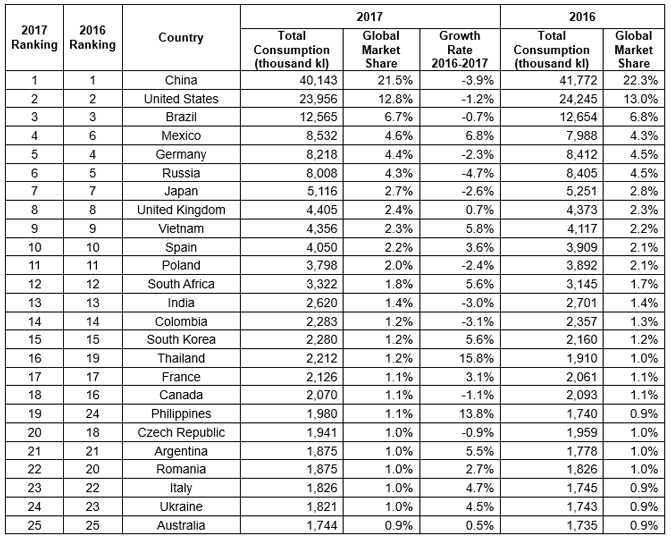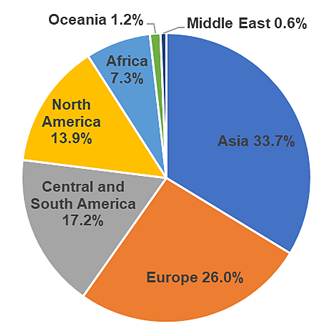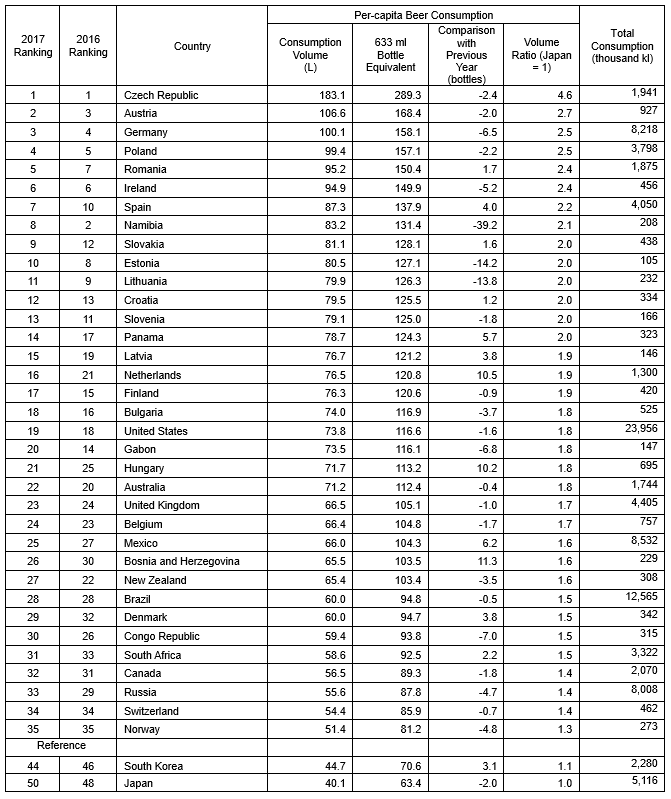- Home
- Newsroom
- News Releases
- 2018
- Kirin Beer University Report Global Beer Consumption by Country in 2017

Kirin Beer University Report Global Beer Consumption by Country in 2017
Global beer consumption falls year-on-year for the third year in a row; Asia remains the top beer-consuming region for the tenth consecutive year
Kirin Company, Limited (President and CEO: Yoshinori Isozaki; hereafter “Kirin”) operates the Kirin Beer University (http://www.kirin.co.jp/entertainment/daigaku/), a virtual university on the Internet which was established in July 2001 to promote the enjoyment of beer and deep knowledge about beer to consumers. With various faculties and facilities, consumers can learn about a variety of topics, ranging from the best way to drink delicious beer to other interesting facts about beer—24 hours a day, 365 days a year.
This report for 2017 publishes the details of global beer consumption in 170 major countries and regions. The report is based on findings obtained from questionnaires sent by Kirin to various brewers’ associations around the world, as well as the latest industry statistics available overseas. The data for global beer consumption has been tracked by Kirin since 1975.
Main Topics
- Global beer consumption stood at approximately 186.72 million kiloliters in 2017, down 0.2% from the previous year, marking the third year-on-year decline in a row. If the volume of the Tokyo Dome was compared to a beer mug, this level of consumption is equivalent to filling up the Tokyo Dome about 151 times over.
- China remained the largest beer-consuming country in the world for the 15th consecutive year; however, consumption decreased significantly in 2017 by 3.9% year-on-year, causing total global consumption to fall. Mexico, in fourth place, marked an 6.8% increase in beer consumption, maintaining growth for two years in a row. Besides Mexico, other countries among the world’s top 10 beer-consuming countries which saw an increase were the United Kingdom, Vietnam, and Spain.
- By region, Asia consumed 0.8% less beer in 2017 compared to 2016, but still holds a 33.7% share of the global beer market, remaining the world’s largest beer-consuming region for the tenth consecutive year. Beer consumption in Africa went up 0.5% from the previous year, marking its seventh year of growth.
In 2017, the global beer consumption was 186.72 million kiloliters (equivalent to approximately 295.0 billion 633 ml bottles), with a decrease of about 330,000 kiloliters, which is equivalent to 0.5 billion 633 ml bottles. In comparison with 2016, there was an annual decrease of 0.2%. The total volume of the global beer consumption is equivalent to about 151 Tokyo Domes, if the stadium was a beer mug with a capacity of about 1.24 million kiloliters.
1. Global Beer Consumption by Country in 2017 (Table 1)
- China remained the largest beer-consuming country in the world for the 15th consecutive year since 2003, despite a decrease of 3.9% compared to 2016.
- Japan was ranked seventh for the 11th consecutive year, consuming 2.6% less beer than 2016.
2. Global Beer Consumption by Region in 2017 (Table 2)
- Although beer consumption decreased in the Asia, North America, and Europe regions, other regions saw consumption increase.
- Asia remained the world’s largest beer-consuming region for the tenth consecutive year, despite a decrease of 0.8% compared to the previous year. Although annual consumption increased in Vietnam (+5.8%), South Korea (+5.6%), Thailand (+15.8%), and the Philippines (+13.8), the decrease in China (-3.9%) resulted in the overall decline.
- Beer consumption in Africa grew for the seventh consecutive year, with an annual increase of 0.5% in 2017.
3. Per-capita Beer Consumption by Country in 2017 (Table 3)
- Czech Republic remained the world’s top in per-capita beer consumption for the 25th consecutive year.
- Among the top 35 countries, 12 saw an increase in consumption from 2016 to 2017.
- Japan consumed 40.1 liters of beer—the equivalent of 63.4 bottles (633 ml)—on a per-capita basis in 2017, down 2.0 bottles year-on-year.
The Kirin Group will aim to create a new beverage culture together with consumers, as well as to further energize and enrich people and society.
Note: Consumption volume in Japan is a combination of beer, happo-shu (low-malt beer), and new genre (non-malt beer). Due to rounding, the figures may not necessarily add up.
Among the countries whose figures for the previous year were revised for this year’s report, the revised figures are used to calculate year-on-year changes.
- *The volume of global consumption for the previous year has been updated (revised from 186.89 million kiloliters to 187.05 million kiloliters).
Source: Questionnaires sent by Kirin to the brewers’ associations in major countries.
The Barth Report Hops 2017/2018 (BARTH−HAAS GROUP)
Global Beverage Forecasts September 2018 (Canadean Ltd.)
- *As of 2013, there has been a change in the industry statistics data source. Therefore, some of the data may not necessarily correspond with past reports.
Table 1: Global Beer Consumption by Country in 2017

Comments
- Global beer consumption in 2017 was approximately 186.72 million kiloliters, down 0.2% from the previous year, marking the third year-on-year decline in a row.
- China remained the largest beer-consuming country in the world for the 15th consecutive year since 2003. There was a 3.9% decrease in annual beer consumption, marking the fourth year-on-year decline in a row. The decrease was due to the maturing and saturation of consumer demand. On the other hand, products in the mid to high price range have been strong.
- Vietnam saw an economic growth rate of 6.8% in 2017, the highest recorded growth rate since 2008. Beer consumption increased by 5.8% compared to 2016 likely due to brisk consumer trends accompanying economic growth leading to an increase in beer intake.
- In the Philippines, beer consumption increased by 13.8% year-on-year due to strong performance in sectors such as manufacturing, service, and agriculture as well as sustained economic expansion, including an improvement in employment. The trend in alcohol consumption is also shifting from the mainstream brandy—which is cheap—toward beer, a high-class product.
Table 2: Global Beer Consumption by Region in 2017

Note: Consumption volume in Japan is a combination of beer, happo-shu (low-malt beer), and new genre (non-malt beer).
2017 Global Market Share of Beer Consumption by Region

Comments
- Annual beer consumption in Asia was the highest in the world for the tenth consecutive year, although there was a decrease of 0.8% from the previous year, with its global market share dropping to 33.7% from last year’s 33.9%.
- Asia remained the top beer-consuming region led by Vietnam, South Korea, Thailand, and the Philippines, which saw year-on-year increases of 5.8%, 5.6%, 15.8%, and 13.8% respectively. However, consumption in China fell by 3.9% year-on-year, leading to an overall decrease in regional consumption for the fourth year in a row.
- Central and South America, ranking third, recorded an increase of 1.3% from the previous year due to increased consumption in Mexico and Argentina of 6.8% and 5.5% respectively.
Table 3: Per-capita Beer Consumption by Country in 2017

Comments
- Czech Republic led all other nations in per-capita beer consumption for the 25th consecutive year.
- Among the top 35 countries ranked by per-capita beer consumption, 12 increased consumption levels from 2016 to 2017.
- *Per-capita consumption of beer in Czech Republic has been revised due to a change in counting method for population after 2002.
- *Starting from this year, countries and regions with total beer consumption of 100,000 kiloliters or less are not included in the report, and previous years’ ranking have been adjusted accordingly.